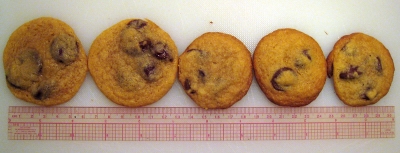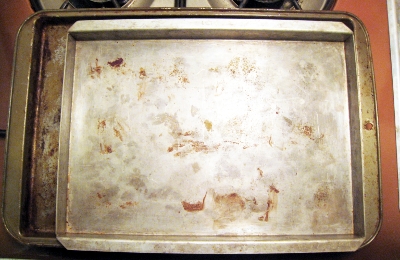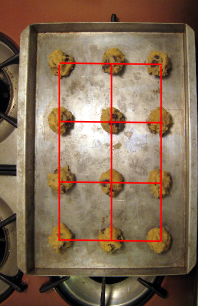Every time I bake cookies, I wonder if I’m making the most of the space on the cookie sheet. I finally decided to stop wondering and figure it out.
Experimental methods
My investigation involved circular cookies of two different sizes:
They were arranged on cookie sheets of two different sizes:
Now, the most common way to arrange cookies is in equally spaced rows and columns. This is called a square lattice; when you draw a line from the center of a cookie to each of its four “nearest neighbors,” you end up with a pattern of squares.
Another option is, instead of putting the cookies in row two directly under the cookies in row one, to arrange them in the “gaps” between the cookies on the first row. If you do this, you get a triangular lattice, also called a hexagonal lattice; when you draw a line from the center of a cookie to each of its six “nearest neighbors,” you get a pattern of triangles.
As you can see, the cookies are more densely packed when they’re in a triangular lattice, even though they’re the same distance away from the cookies closest to them. If you work out the geometry problem, it turns out that cookies arranged in a triangular lattice take up 86.6 percent as much space as cookies in a square lattice. In other words, you can fit 15 percent more cookies into the same amount of area.
Well, problem solved! Triangular lattice it is.
But wait! What if your cookie sheet isn’t wide enough for an offset second row? Is the triangular lattice still the way to go? Is it still worth it to get the rows closer together, when it means every other row is a cookie short?
To find the answer to these questions, I first tested the four different set-ups in my kitchen (small cookies on a small cookie sheet, small cookies on a large cookie sheet, large cookies on a small cookie sheet, and large cookies on a large cookie sheet). Then I used equations and graphs to generalize the answers.
Continue reading →


 The sides are, in fact,
The sides are, in fact, 
